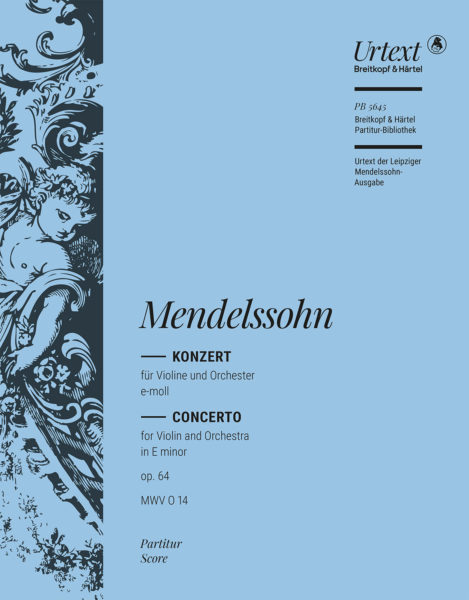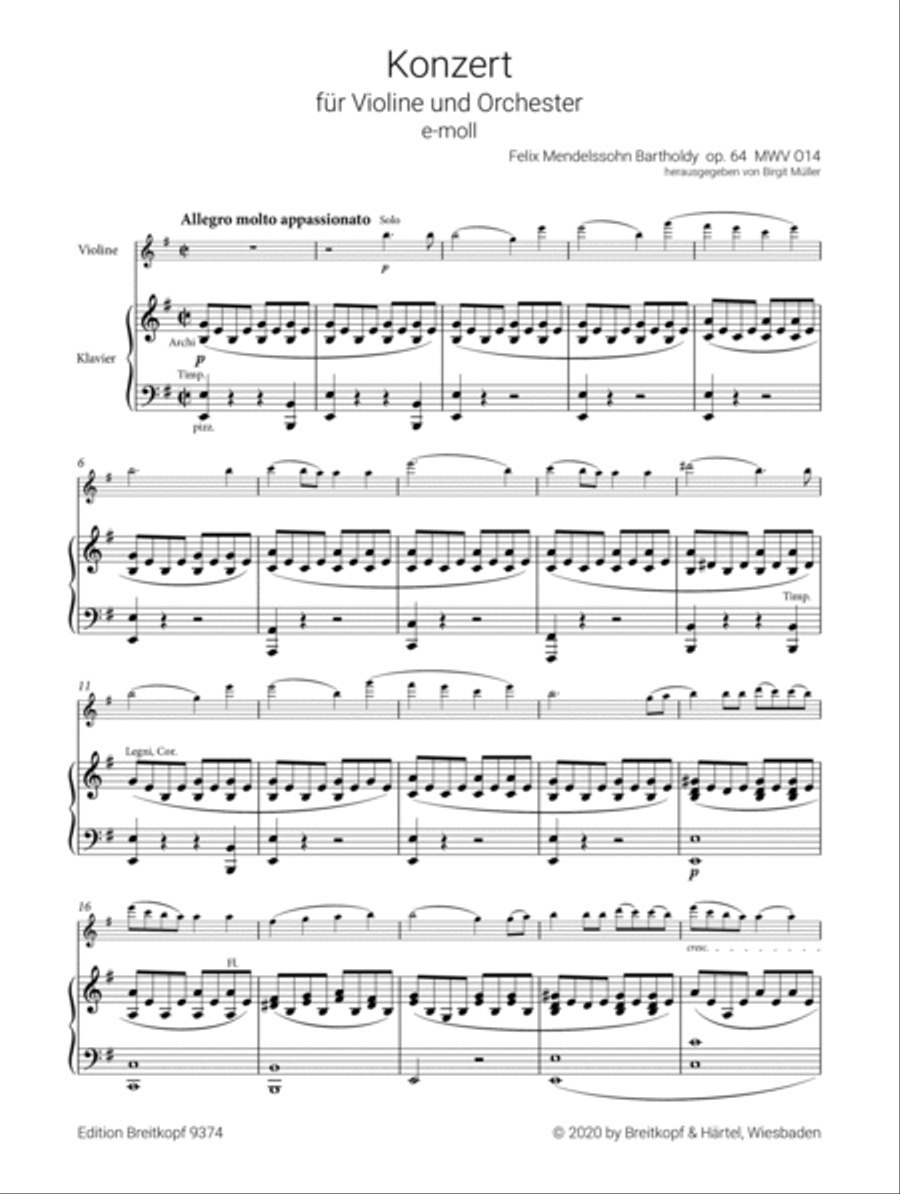
Happy Present Meet

Mendelssohn Concerto in E minor Op.64 MWV O 14 for Violin and Piano (revised)
replacement item no. EB7406
Urtext based on the Leipzig Mendelssohn Complete Edition edited by Birgit Müller [vl,orch] Duration: 25'
1. Allegro molto appassionato
2. Andante – Allegretto non troppo
3. Allegro molto vivace
Felix Mendelssohn Bartholdy created a standard work with his final violin concerto in E minor op. 64 MWV O 14 that is now firmly established in today's concert repertoire. When in 1838 the composer indicated that he had "in mind a violin concerto [...] in E minor [...]," it was not only his friend Ferdinand David, the Gewandhaus concertmaster for whom it was intended, who was euphoric. The "whole civilized violin world" was awaiting this concerto - and yet it was another seven years before the much-anticipated composition was ultimately published by the Leipzig publishing house Breitkopf & Hartel in June 1845, as well as simultaneously in London and Milan. The concerto particularly appeals through its innovative treatment of the solo part, not only because the solo violin strikingly opens the first movement without a preceding orchestral tutti, but also because of its musical dialogue with the orchestra. The Leipzig Gewandhaus premiere on 13 March 1845 with Ferdinand David as soloist under the direction of Nils Wilhelm Gade served - as so frequently with Mendelssohn - virtually as a proofreading process. After the composer subsequently made extensive changes that also involved David, the work first appeared just short of nine months later. The first edition documents the composer's valid final revision, which is reproduced as the work's main version in the present Urtext edition. The matching piano reduction includes not only an unmarked string part, but also a part with the established markings by Igor Oistrach.
펠릭스 멘델스존 바르톨디는 그의 마지막 바이올린 협주곡 E단조 작품번호 64 MWV O 14를 통해 오늘날의 콘서트 레퍼토리에 확고히 자리 잡은 표준적인 작품을 만들어냈습니다. 1838년, 작곡가가 "바이올린 협주곡 [...]을 E단조로 구상하고 있다"고 밝혔을 때, 이 협주곡이 작곡될 예정이었던 그의 친구이자 게반트하우스 콘서트마스터인 페르디난트 다비드만이 기뻐한 것은 아니었습니다. "온 문명 바이올린계"가 이 협주곡을 기다리고 있었지만, 많은 기대를 모았던 이 작품은 1845년 6월 라이프치히 출판사인 브라이트코프 운트 하르텔에서 출판되었고, 런던과 밀라노에서도 동시에 출판되기까지 7년이 걸렸습니다. 이 협주곡은 특히 독주 파트를 혁신적으로 처리하여 관객의 관심을 사로잡습니다. 독주 바이올린이 오케스트라의 투티 없이 1악장을 강렬하게 시작할 뿐만 아니라, 오케스트라와의 음악적 대화를 이끌어내기 때문입니다. 1845년 3월 13일, 닐스 빌헬름 가데의 지휘 아래 페르디난트 다비드가 독주자로 나선 라이프치히 게반트하우스 초연은 멘델스존의 경우처럼 사실상 교정 과정과 같은 역할을 했습니다. 이후 작곡가가 다비드까지 포함한 광범위한 수정 작업을 거친 후, 이 작품은 9개월도 채 지나지 않아 처음 출판되었습니다. 초판에는 작곡가의 유효한 최종 수정본이 수록되어 있으며, 이는 현재 원전(Urtext)에 작품의 주요 버전으로 수록되어 있습니다. 피아노 악보에는 표기가 없는 현악 파트뿐만 아니라 이고르 오이스트라흐가 표기한 파트도 포함되어 있습니다.
작곡가 Mendelssohn, Felix (1809-1847)
에디터 Birgit Muller

Tchaikovsky Violin Concerto in D Major Op.35 for Violin and Piano
Bach - Busoni Prelude and Fugue in D major BWV 532 arr. for Piano Solo
Scriabin 12 Etudes Op.8 for Piano Solo
Brahms Paganini Variations Op.35 for Piano Solo
Chopin Sonata No.2 in Bb minor Op.35 for Piano Solo
Schumann Paganini Etudes Op.3 and Op.10 for Piano Solo
Schumann Piano Sonata No.1 in f Sharp minor Op.11 for Piano Solo
Schumann Piano Sonata No.3 (Grand Sonata) in f minor Op.14 for Piano Solo (1836/1853)
Schumann Piano Sonata No.2 in g minor Op.22 for Piano Solo
Bach Chromatic Fantasy and Fugue d minor BWV 903 and 903a (without fingering)